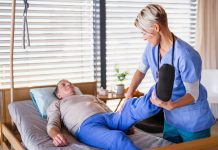
Imagine waking up one day, feeling disoriented, and realizing that something is terribly wrong. That’s what happened to Larry Christian when he experienced sudden pain in his left hand and arm at 3 o’clock in the morning.
He dismissed it and went back to sleep, but the next day, he faced a new reality. Larry couldn’t keep his balance, and it was evident that something serious had occurred – he had suffered a hemorrhagic stroke.
This life-altering event led Larry to seek rehabilitation at the University of Delaware’s Physical Therapy Clinic.
He became part of a clinical trial that aimed to investigate whether high-intensity interval training (HIIT) could improve gait in stroke survivors. His journey, like many others, demonstrated the potential for remarkable recovery.
The Challenge of Stroke Rehabilitation
Stroke is a devastating medical condition, affecting millions of people in the United States alone.
Among the 7 million stroke survivors in the country, fewer than 10% regain adequate walking speed and endurance to perform daily activities independently, such as grocery shopping. Many face challenges related to balance, coordination, and overall mobility.
Rehabilitation is a crucial part of the recovery process for stroke survivors. Traditional approaches have often focused on gentle exercises and caution due to concerns about patients’ overall health.
However, emerging research suggests that a different approach, involving high-intensity interval training (HIIT), may offer more promising results.
The HIIT Clinical Trial: A Game-Changer
Larry Christian’s journey to recovery included participation in a clinical trial led by researchers at the University of Delaware, the University of Cincinnati, and the University of Kansas Medical Center.
This multi-million-dollar, five-year clinical trial aimed to explore the effects of HIIT on walking capacity among chronic stroke survivors.
The results of the trial, recently published in JAMA Neurology, were groundbreaking.
Participants who engaged in HIIT, which involved bursts of maximum-speed walking alternated with recovery periods, demonstrated a significant improvement in their walking capacity over 12 weeks.
This improvement was particularly dramatic for many, marking a potential turning point in stroke rehabilitation.
Expanding the Impact
While the initial clinical trial provided valuable insights, the researchers recognized the need for a larger sample size to ensure the findings could represent the broader stroke survivor population accurately.
As a result, they secured a renewal grant from the National Institutes of Health (NIH) worth over $3.4 million to expand their study to 165 participants.
The expansion of the study aims to answer critical questions about the optimal exercise program for stroke survivors. HIIT can take various forms, tailored to each individual’s capabilities and needs.
Some may benefit from speed-focused exercises, while others might require additional resistance or inclines to challenge their progress.
The Road Ahead: Changing Lives
The journey of stroke survivors like Larry Christian highlights the potential of HIIT in stroke rehabilitation. It offers not only physical improvements but also a sense of empowerment and accomplishment.
Participants report increased energy, enhanced daily activities, and a reduced sense of fatigue during everyday tasks.
The future of stroke rehabilitation may involve a shift towards incorporating high-intensity exercise regimens, revolutionizing the standard of care.
However, implementing this change requires more than just tools and training; it relies on evidence, education, and the continuous dedication of healthcare professionals.
As researchers gather more data and evidence on the benefits of HIIT for stroke survivors, the hope is that this intervention will change lives, offering newfound independence, mobility, and a brighter future for those affected by stroke.
If you care about stroke, please read studies about how to eat to prevent stroke, and diets high in flavonoids could help reduce stroke risk.
For more information about health, please see recent studies about how Mediterranean diet could protect your brain health, and wild blueberries can benefit your heart and brain.
The research findings can be found in JAMA Neurology.
Follow us on Twitter for more articles about this topic.
Copyright © 2023 Knowridge Science Report. All rights reserved.



